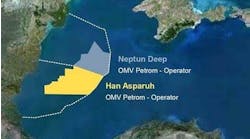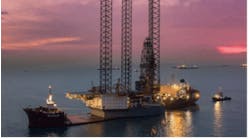Single run footage climbing for new technology
- FBS turbodrill with bent housing [14,879 bytes]
- FBS steerable trubodrill achievements [30,558 bytes]
- Turbodrill rotors and stators are shown being assembled, along with an assembled version [23,473 bytes]
In April 1997 a 4 3/4 -in. FBS steerable turbodrill with a 6-in. impregnated diamond bit drilled 5,145 ft in the first lateral of a re-entry well in Shell Expro's Galleon Field, drilled from Santa Fe's jack-up rig Britannia. The run recorded the longest single-run footage, with a 6-in. diamond bit, beating the previous record by 828 ft, and exceeded the cumulative footage recorded by any 6-in. diamond bit.
The steerable turbodrill was used to build the angle of the well from 72 degrees and complete a horizontal section of some 5,000 ft, which included a 50 degree right-hand turn to follow the planned course of the well to its final measured depth of over 20,000 ft. The steerable turbodrill then successfully completed an open-hole sidetrack and a flat right-hand turn at 8 degrees/100 ft before going on to complete the second leg in a single run.
The successful development of a 4 3/4-in. steerable turbodrill and horizontal turbodrilling techniques is the result of collaboration between engineers from Shell Expro, Santa Fe Drilling, and Neyrfor-Weir over the last four years. The aim of the collaboration was to improve the drilling performance through the sandstone reservoir over the traditionally used polycrystalline diamond compact (PDC) bit and steerable positive displacement motor (PDM) combination.
The initial goal was to maximize run length and reduce the costly trip time often seen on these wells. Due to the varying drillability of the Rotliegendes Sandstone reservoir section, the PDC/PDM combination yielded mixed performance with inconsistent run lengths, ROPs and highly variable cost per foot.
Initial problems
The debut run for the 4 3/4-in. steerable turbodrill in May 1993 ended in disaster with both prototype tools suffering mechanical failure. Within four months, the problems were addressed and Shell Expro and Santa Fe kept faith. The modified tool drilled to total depth a well in the Clipper Field with a run of 2,285 ft. In the intervening four years, 4 3/4-in. steerable turbodrills have been used in 19 Shell Expro wells to drill over 76,000 ft, most of it horizontal.In January 1994, a 4 3/4-in. turbodrill successfully complete an open-hole sidetrack from the first leg of a dual-lateral well in the Barque Field and then drilled 4,317 ft to TD the second leg at 16,025 ft.
The uninterrupted run spanned 12 days and 247 turbodrill operating hours were recorded. A telling comparison between steerable turbodrill and positive displacement motor performance occurred in another Barque well. The 6-in. section was drilled to 17,740 ft before it was decided to sidetrack the well for geological reasons.
Nine separated runs with positive displacement motors were required to drill 3,495 ft in this sidetracked 6-in. section to a total depth of 20,115 ft. Further progress was not possible and it was decided to begin a second sidetrack and re-drill the entire 6-in. section. The longest positive displacement motor run in the first sidetracked section lasted 33 hours and the average drilling time over the 9 runs was 26 hours. Average footage per run was 388 ft and the maximum recorded in one run was 748 ft.
Three runs with 4 3/4-in. turbodrills account ed for 5,196 ft in the second sidetracked 6-in. section. The final run drilled 2,128 ft (three times the best footage achieved with a positive displacement motor) and took the well to its along-hole depth of 21,560 ft. Shell Expro attributed cost savings of US $500,000 to the use of steerable turbodrills rather than positive displacement motors in the second sidetracked section.
Longer runs
Whilst steerable turbodrill ROP has been superior to PDM ROP, the major savings are attributable to the greater run lengths. Many horizontal sections are completed with a single run, which confers a significant improvement in gross ROP (footage drilled divided by total elapsed time to drill the section).In the Barque Field well PB02, the gross ROP with the steerable turbodrill was 15 ft/hr, or double the best PDM performance - halving the time to drill the section. Mean time between failure (MTBF) for the turbodrill is 979 hours, over some 9,000 hours of operation, of which around half have been recorded in wells drilled by Shell Expro's Southern Field Unit.
Other users of the 4 3/4-in. steerable turbodrill in the Southern North Sea include Arco (Trent), BP (West Sole and Newsham), Conoco (Murdoch), Lasmo (Markham), and Mobil (Gawain).
Key factors
The key technical factors contributing to the success of turbodrilling in horizontal sections are the following:- Introduction of an effective bent housing into the turbodrill design
- Significant reduction in turbodrill length without sacrificing power
- Pressure profile turbine stages, which deliver more power per stage than conventional turbine stages
- Fully stabilized turbodrills with a rig-changeable mid-body stabilizer to allow good directional control
- Long gauge bits with box connections made up directly onto the turbine drive shaft.
A traditional 4 3/4-in. turbodrill has three sections with an overall length of 49 ft. The development of pressure profile turbine stages has allowed the number of turbine stages to be halved, thereby reducing the number of sections by one and reducing the overall length to 29 ft.
While delivering more power per stage, the pressure profile blades also have another useful characteristic. The pressure drop through the stages varies with speed and torque like that of a positive displacement motor, but in an opposite relationship. The turbodrill drops pressure as torque increases and speed decreases. This characteristic enables an experienced operator to effectively monitor turbodrill speed and hence drillbit speed, to facilitate improved performance drilling and steering.
The use of fully stabilized turbodrills improves hole quality which reduces torque and facilitates easier sliding. A critical review of turbodrill and positive displacement motor performances in a number of Leman Field wells showed average run length for stabilized turbodrills to be 4,743 ft compared to 789 ft for unstabilized positive displacement motors. Stabilized turbodrill average ROP was 20% greater than that with unstabilized positive displacement motors.
The initial runs with the 4 3/4-in. turbodrill used short gauge pin connection bits and some steering problems were encountered. The solution was to modify the bit and turbine to smooth the bit/turbine transition. The bit design was changed to incorporate a box connection and an extended gauge (usually 10 in./12 in.).
This, contrary to popular directional drilling wisdom, increased the tool's dogleg capability compared to that with standard short gauge bits. The connection at the bottom of the turbine drive shaft was changed to a pin, thereby eliminating the traditional bit box stabilizer. Box connection long gauge bits are now available from all the major bit manufacturers.
The re-entry of existing wells to drill new dual laterals through reservoir sections is likely to be an increasing feature of Southern Gas Basin operations over the next few years. Steerable turbodrilling techniques are well established for the tool to play a role in this phase of gas field development.
Copyright 1997 Oil & Gas Journal. All Rights Reserved.


